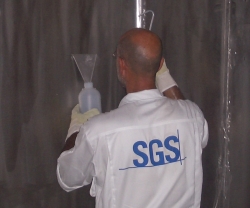 Permanganate Time Test
Permanganate Time Test
The Permanganate time is used to judge the presence of oxidizable materials that may be associated with contamination during distribution and to access compliance with a specification. The test is based on the ability of potassium permanganate (KMnO4) to oxidise hydrocarbon impurities that could be present in the wall wash liquid. If there is a reaction in a neutral solution, the potassium permanganate is reduced and changes its colour from pink-orange to yellow-orange. The more impurities the faster a change in colour occurs.
Water Miscibility (hydrocarbon test) The purpose of this test is the qualitative detection of non-water-soluble contaminants. It works on the basis that many impurities are soluble in the wall wash liquid (Methanol, Acetone) but not in water. Sometimes this test is also called Hydrocarbon test.
Chloride Test The Chloride test is used the judge the presence of chlorides on bulkheads etc. Chloride levels vary from 0.1 ppm to 5 ppm depending on the requirement of the charterer. Chlorides will react with Silver nitrate/nitric acid solution forming Silver chloride (AgCl) which makes the solution turbid. By comparing the sample solution with the various prepared standard solutions one can establish the ppm chlorides in the wall wash.
Colour Test Certain impurities result in discoloration of the wall wash sample. The colour of the wall wash liquid is compared with unused wall wash solvent. Mostly the so-called Apha colour is measured.
UV Test The UV-Test is used to identify certain hydrocarbons and chemicals. Many hydrocarbons and chemicals have the ability to absorb UV-light when they are exposed to such light. Certain molecular electrons will get exited if exposed to light. This exitation results in absorbance of light which can be measured. Absorbance at a specific wavelength is a measure for concentration of specific compounds. In a special apparatus called Spectrometer a sample (containing hydrocarbons) and a reference sample (containing just a solvent such as methanol) are exposed to a UV light source.
Acid Wash The Acid Wash Test Method is used to determine the presence of Benzene, Toluene, Xylenes, refined Solvent Naphthas, and similar industrial aromatic hydrocarbons. This test is also used for detecting of impurities in methanol. Compounds which cause darkening in the presence of concentrated sulphuric acid due to carbonization can be detected with this test. In Methanol analysis this is often referred to as Carbonizables
NVM Test Used to determine if there are non-volatile impurities on the tank surface. A defined quantity of the wall wash liquid is evaporated. The weight of the residue, the so-called NVM (Non Volatile Matter), is detected by weighing. This is then divided by the original weight of the sample. The NVM content must not exceed the value specified by the loader.